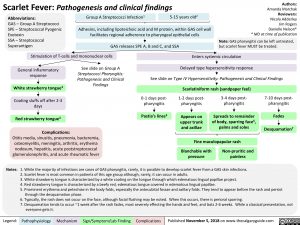Scarlet Fever: Pathogenesis and clinical findings
Authors:
Amanda Marchak
Reviewers:
Nicola Adderley Jim Rogers Danielle Nelson* * MD at time of publication
Note: GAS pharyngitis can be left untreated, but scarlet fever MUST be treated.
Enters systemic circulation
Delayed type hypersensitivity response
See slide on Type IV Hypersensitivity: Pathogenesis and Clinical Findings
Abbreviations:
GAS – Group A Streptococci SPE – Streptococcal Pyogenic
Exotoxin
SSA – Streptococcal Superantigen
Group A Streptococci Infection1 5-15 years old2
Adhesins, including lipoteichoic acid and M protein, within GAS cell wall facilitates regional adherence to pharyngeal epithelial cells
GAS releases SPE A, B and C, and SSA Stimulation of T-cells and mononuclear cells
General inflammatory response
White strawberry tongue3
Coating sluffs off after 2-3 days
Red strawberry tongue4
Complications:
See slide on Group A Streptococci Pharyngitis: Pathogenesis and Clinical Findings
Scarlatiniform rash (sandpaper feel)
0-1 days post- pharyngitis
Pastia’s lines5
1-2 days post- pharyngitis
Appears on upper trunk and axillae
3-4 days post- pharyngitis
Spreads to remainder of body, sparring face6, palms and soles
7-10 days post- pharyngitis
Fades Desquamation7
Otitis media, sinusitis, pneumonia, bacteremia, osteomyelitis, meningitis, arthritis, erythema nodosum, hepatitis, acute poststreptococcal glomerulonephritis, and acute rheumatic fever
Fine maculopapular rash
Blanchable with Non-pruritic and pressure painless
Notes:
1. While the majority of infections are cases of GAS pharyngitis, rarely, it is possible to develop scarlet fever from a GAS skin infections. 2. Scarlet fever is most common in patients of this age group although, rarely, it can occur in adults.
3. White strawberry tongue is characterized by a white coating on the tongue through which edematous lingual papillae project.
4. Red strawberry tongue is characterized by a beefy red, edematous tongue covered in edematous lingual papillae.
5. Prominent erythema and petechiae in the body folds, especially the antecubital fossae and axillary folds. They tend to appear before the rash and persist through the desquamation phase.
6. Typically, the rash does not occur on the face, although facial flushing may be noted. When this occurs, there is perioral sparring.
7. Desquamation tends to occur ~1 week after the rash fades, most severely effecting the hands and feet, and lasts 2-6 weeks. While a classical presentation, not
everyone gets it.
Legend:
Pathophysiology
Mechanism
Sign/Symptom/Lab Finding
Complications
Published November 5, 2018 on www.thecalgaryguide.com
Foundations
Systems
Other Languages
Pediatrics Common Pediatric Infections Scarlet Fever: Pathogenesis and clinical findings Scarlet Fever: Pathogenesis and clinical findings

